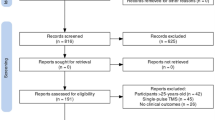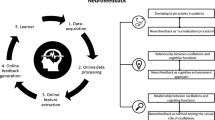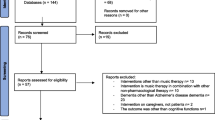Abstract
To investigate whether a period of continuous theta burst stimulation (cTBS) over the supplementary motor area (SMA) induces cortical plasticity and thus improves bradykinesia in Parkinson’s disease (PD) in the medication ON and OFF state. In total, 26 patients with Parkinson’s disease were tested with both real and sham stimulation. The group was divided into an OFF-medication (4 females, mean age 65 years, disease duration 6 years) and an ON-medication group (7 females, mean age 61 years, disease duration 7 years) with each containing 13 individuals. Both groups were evaluated in terms of electrophysiological (motor-evoked potentials) and behavioural [Purdue Pegboard test (PPT), UPDRS motor subscore] parameters before (baseline condition) and after a 40-second period of real or sham continuous theta burst stimulation over the SMA ON and OFF dopaminergic drugs. Patients in the OFF group demonstrated an improved UPDRS III score (p < 0.05) and a better performance in the PPT for the less affected side (p < 0.025) compared to baseline after real stimulation. However, electrophysiological parameters did not change in either the ON or the OFF state. cTBS over the SMA has a mild effect on motor symptoms of the upper limb in the OFF state of PD patients. In contrast, stimulation did not change cortico-spinal excitability. A lack of change (i.e. no plasticity) to brain stimulation protocols is a known finding in PD. A clinical improvement in the OFF state, however, contrasts with this and the mechanism of these induced changes is worth further exploration.

Similar content being viewed by others
References
Benabid AL, Chabardes S, Mitrofanis J, Pollak P (2009) Deep brain stimulation of the subthalamic nucleus for the treatment of Parkinson’s disease. Lancet Neurol 8:67–81
Wu AD, Fregni F, Simon DK, Deblieck C, Pascual-Leone A (2008) Noninvasive brain stimulation for Parkinson’s disease and dystonia. Neurother J Am Soc Exp Neurother 5:345–361
Siebner HR, Rothwell J (2003) Transcranial magnetic stimulation: new insights into representational cortical plasticity. Exp Brain Res 148:1–16
Lefaucheur JP (2009) Treatment of Parkinson’s disease by cortical stimulation. Expert Rev Neurother 9:1755–1771
Huang YZ, Edwards MJ, Rounis E, Bhatia KP, Rothwell JC (2005) Theta burst stimulation of the human motor cortex. Neuron 45:201–206
Nachev P, Kennard C, Husain M (2008) Functional role of the supplementary and pre-supplementary motor areas. Nat Rev Neurosci 9:856–869
Jenkins IH, Fernandez W, Playford ED, Lees AJ, Frackowiak RS, Passingham RE et al (1992) Impaired activation of the supplementary motor area in Parkinson’s disease is reversed when akinesia is treated with apomorphine. Ann Neurol 32:749–757
Brooks DJ, Piccini P, Turjanski N, Samuel M (2000) Neuroimaging of dyskinesia. Ann Neurol 47:S154–S158 (discussion S8–9)
Randhawa BK, Farley BG, Boyd LA (2013) Repetitive transcranial magnetic stimulation improves handwriting in Parkinson’s disease. Parkinson’s Dis 2013:751925
Shirota Y, Ohtsu H, Hamada M, Enomoto H, Ugawa Y (2013) Research Committee on r TMSToPsD. Supplementary motor area stimulation for Parkinson disease: a randomized controlled study. Neurology 80:1400–1405
Hamada M, Ugawa Y, Tsuji S (2009) Effectiveness of rTms on Parkinson’s Disease Study Group J. High-frequency rTMS over the supplementary motor area improves bradykinesia in Parkinson’s disease: subanalysis of double-blind sham-controlled study. J Neurol Sci 287:143–146
Boylan LS, Pullman SL, Lisanby SH, Spicknall KE, Sackeim HA (2001) Repetitive transcranial magnetic stimulation to SMA worsens complex movements in Parkinson’s disease. Clin Neurophysiol 112:259–264
Chen R, Classen J, Gerloff C, Celnik P, Wassermann EM, Hallett M et al (1997) Depression of motor cortex excitability by low-frequency transcranial magnetic stimulation. Neurology 48:1398–1403
Pascual-Leone A, Valls-Sole J, Wassermann EM, Hallett M (1994) Responses to rapid-rate transcranial magnetic stimulation of the human motor cortex. Brain 117(Pt 4):847–858
Laviolette L, Nierat MC, Hudson AL, Raux M, Allard E, Similowski T (2013) The supplementary motor area exerts a tonic excitatory influence on corticospinal projections to phrenic motoneurons in awake humans. PLoS One 8:e62258
Legon W, Dionne JK, Staines WR (2013) Continuous theta burst stimulation of the supplementary motor area: effect upon perception and somatosensory and motor evoked potentials. Brain Stimul 6:877–883
Crovitz HF, Zener K (1962) A group-test for assessing hand- and eye-dominance. Am J Psychol 75:271–276
Hamada M, Ugawa Y, Tsuji S, Effectiveness of rTms on Parkinson’s Disease Study Group J (2008) High-frequency rTMS over the supplementary motor area for treatment of Parkinson’s disease. Mov Disord 23:1524–1531
Matsunaga K, Maruyama A, Fujiwara T, Nakanishi R, Tsuji S, Rothwell JC (2005) Increased corticospinal excitability after 5 Hz rTMS over the human supplementary motor area. J Physiol 562:295–306
Terao Y, Furubayashi T, Okabe S, Mochizuki H, Arai N, Kobayashi S et al (2007) Modifying the cortical processing for motor preparation by repetitive transcranial magnetic stimulation. J Cogn Neurosci 19:1556–1573
Lisanby SH, Gutman D, Luber B, Schroeder C, Sackeim HA (2001) Sham TMS: intracerebral measurement of the induced electrical field and the induction of motor-evoked potentials. Biol Psychiatry 49:460–463
Rossi S, Hallett M, Rossini PM, Pascual-Leone A, Safety of TMSCG (2009) Safety, ethical considerations, and application guidelines for the use of transcranial magnetic stimulation in clinical practice and research. Clin Neurophysiol 120:2008–2039
Elahi B, Chen R (2009) Effect of transcranial magnetic stimulation on Parkinson motor function–systematic review of controlled clinical trials. Mov Disord 24:357–363
Trost M, Su S, Su P, Yen RF, Tseng HM, Barnes A et al (2006) Network modulation by the subthalamic nucleus in the treatment of Parkinson’s disease. NeuroImage 31:301–307
Bradberry TJ, Metman LV, Contreras-Vidal JL, van den Munckhof P, Hosey LA, Thompson JL et al (2012) Common and unique responses to dopamine agonist therapy and deep brain stimulation in Parkinson’s disease: an H(2)(15)O PET study. Brain Stimul 5:605–615
Mure H, Tang CC, Argyelan M, Ghilardi MF, Kaplitt MG, Dhawan V et al (2012) Improved sequence learning with subthalamic nucleus deep brain stimulation: evidence for treatment-specific network modulation. J Neurosci 32:2804–2813
Shulman LM, Gruber-Baldini AL, Anderson KE, Fishman PS, Reich SG, Weiner WJ (2010) The clinically important difference on the unified Parkinson’s disease rating scale. Arch Neurol 67:64–70
Gonzalez-Garcia N, Armony JL, Soto J, Trejo D, Alegria MA, Drucker-Colin R (2011) Effects of rTMS on Parkinson’s disease: a longitudinal fMRI study. J Neurol 258:1268–1280
Siebner HR, Lang N, Rizzo V, Nitsche MA, Paulus W, Lemon RN et al (2004) Preconditioning of low-frequency repetitive transcranial magnetic stimulation with transcranial direct current stimulation: evidence for homeostatic plasticity in the human motor cortex. J Neurosci 24:3379–3385
Kishore A, Popa T, Velayudhan B, Joseph T, Balachandran A, Meunier S (2012) Acute dopamine boost has a negative effect on plasticity of the primary motor cortex in advanced Parkinson’s disease. Brain 135:2074–2088
Ueki Y, Mima T, Kotb MA, Sawada H, Saiki H, Ikeda A et al (2006) Altered plasticity of the human motor cortex in Parkinson’s disease. Ann Neurol 59:60–71
Ortu E, Ruge D, Deriu F, Rothwell JC (2009) Theta Burst Stimulation over the human primary motor cortex modulates neural processes involved in movement preparation. Clin Neurophysiol 120:1195–1203
Hamada M, Murase N, Hasan A, Balaratnam M, Rothwell JC (2013) The role of interneuron networks in driving human motor cortical plasticity. Cereb Cortex 23:1593–1605
Sommer J, Jansen A, Drager B, Steinstrater O, Breitenstein C, Deppe M et al (2006) Transcranial magnetic stimulation–a sandwich coil design for a better sham. Clin Neurophysiol 117:440–446
Fregni F, Boggio PS, Bermpohl F, Maia F, Rigonatti SP, Barbosa ER et al (2006) Immediate placebo effect in Parkinson’s disease–is the subjective relief accompanied by objective improvement? Eur Neurol 56:222–229
Acknowledgments
This study was supported by a grant of the “Felgenhauer-Stiftung zur Förderung junger Neurowissenschaftler”.
Conflicts of interest
C.E. occasionally received honoraria from Medtronic Inc., TEVA Pharma and UCB Pharma for lecturing at conferences or consulting work. The institution of C.E., not C.E. personally received funding by the German Research Foundation (DFG), Köln Fortune, Medtronic Inc., Bayer Healthcare, UCB Pharma, Abbott and Zur Rose Pharma. M.G. did not report any disclosures. J.R. has no disclosures relevant to this manuscript. L.T. received payments as a consultant for Medtronic Inc., Boston Scientific, Bayer Healthcare, UCB Schwarz Pharma and Sapiens. L.T. received honoraria as a speaker on symposia sponsored by TEVA Pharma, Lundbeck Pharma, Bracco, Gianni PR, Medas Pharma, UCB Schwarz Pharma, Desitin Pharma, Boehringer Ingelheim, GlaxoSmithKline, Eumecom, Orion Pharma, Medtronic Inc., Boston Scientific, Cephalon, Abott, GE Medical. The institution of L.T., not L.T. personally, received funding by the German Research Foundation (DFG), the German Ministry of Education and Research, Manfred und Ursula Müller Stiftung, Klüh Stiftung, Hoffnungsbaum e. V., NBIA DISORDERS SOCIETY USA, Köln Fortune, Medtronic Inc., UCB Schwarz Pharma, Bayer Healthcare, zur Rose Pharma, Abbvie, Archimedes Teva and Deutsche Parkinson Vereinigung. D.R. has no disclosures relevant to this manuscript.
Ethical standard
This study has been approved by the local ethics committee (approval number EK 09-235) and has therefore been performed in accordance with the ethical standards laid down in the 1964 Declaration of Helsinki.
Author information
Authors and Affiliations
Corresponding author
Rights and permissions
About this article
Cite this article
Eggers, C., Günther, M., Rothwell, J. et al. Theta burst stimulation over the supplementary motor area in Parkinson’s disease. J Neurol 262, 357–364 (2015). https://doi.org/10.1007/s00415-014-7572-8
Received:
Revised:
Accepted:
Published:
Issue Date:
DOI: https://doi.org/10.1007/s00415-014-7572-8




